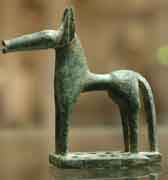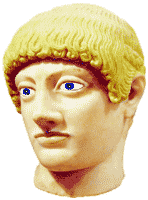.
Parts : 1 - 2 - 3 - 4 - 5 - 6 - 7 - 8 -
Sculptures from the Archaic to the Hellenistic Period
Αρχαία ελληνική μνημειακή γλυπτική από την αρχαϊκή έως την ελληνιστική περίοδο
Daidalos (or Daedalus), the greatest maker of statues, was the first to open their eyelids, so that they appear to see, and to separate the feet, so that they appear to walk. And because of this he bound them, in order that they might not run away, as if they were living and breathing, Scholiast on Plato Meno
989 BC. Daedalus and his nephew Talus invent the saw, the turning-lath, the wimble, the chipax, and other instruments of Carpenters and Joyners, and thereby give a beginning to those Arts in Europe. Daedalus also invented the making of Statues with their feet asunder, as if they walked. Sir Isaac Newton, A short chronicle: From the First Memory of things in Europe to the Conquest of Persia by Alexander the Great
Greek Bronze Techniques (Animations), Requires Java Sphyrelaton Method (Hammer Driven), Solid Lost-Wax Casting Methods (Direct and Indirect)
Konstam's discoveries on Ancient Greek Bronze Techniques , The Bronze-Casting Techniques
The Kourotrophos from Megara Hyblaea
The Evolution of Archaic Greek Art
The archaic Artemis Temple with one of the earliest Pediment figures. The problem of covering a triangular shape with figures solved by a primitive method.
The Artemis Temple and Medusa in Corfu

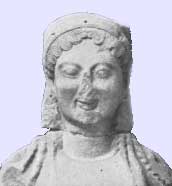
The Naxian Lions Terrace of Delos
Ancient Greek Coins are often masterpieces of Art.
The world's most valuable coin in the world, the Aitna tetradrachm.(2MB PDF)
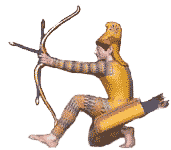
The East Pediment figures of the Aphaia Temple were produced only around 10 years later than the figures of the West Pediment. The comparison showns a significant evolution of Greek Art in this period .
The Aphaia Temple Pediment Sculptures

Dedication of Polyzalos, one of the sons of Deinomenos the tyrant of Gela in Sicily after winning a Pythian Games chariot race (478/0) BC.
The Charioteers of Delphi and Motya


The Nike (a symbol of victory) flying from the Olymp lands on a column in front of the Zeus Temple in Olympia to honour the athletes of the Olympic Games..
The Nike of Paionios victory column in Olympia and a variation in Germany, the Siegessäule of Berlin
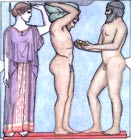
Image Source Color Reconstruction from an Australian Museum
Hercules and the Twelve Labours in the Olympia Zeus Temple
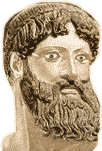
Poseidon (or Zeus) of Artemision

Apollo of Tiber , Massimo608 (a copy of an original bronze sculpture)
Parts : 1 - 2 - 3 - 4 - 5 - 6 - 7 - 8 -
| Ancient Greece
Science, Technology , Medicine , Warfare, , Biographies , Life , Cities/Places/Maps , Arts , Literature , Philosophy ,Olympics, Mythology , History , Images Medieval Greece / Byzantine Empire Science, Technology, Arts, , Warfare , Literature, Biographies, Icons, History Modern Greece Cities, Islands, Regions, Fauna/Flora ,Biographies , History , Warfare, Science/Technology, Literature, Music , Arts , Film/Actors , Sport , Fashion --- |

